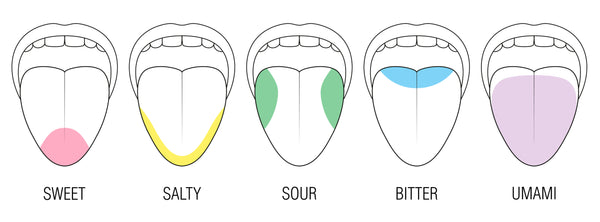We’ve already discussed some key notes on how to do a tea tasting. In this article, we will focus specifically on what those characteristics are. In fact, the different flavors of tea do not lie solely in one category but divide into 3 subgroups: flavor, mouthfeel, and aroma. Flavor is often mistaken with aroma, for instance, when we describe a tea as tasting like a flower meadow or a fruit salad.
All tea types come from the same plant, Camellia sinensis. So what makes them so vastly different?
The most significant difference between all the different types of tea lies in the levels of oxidation/fermentation that the tea leaves go through and the processing. In addition to this, there can be countless other variables on which the final taste will depend. For example: the tea farm location, weather conditions, storage area, processing technique, and even our own brewing.
The 5 Flavors of Tea
Our tongues are able only to taste 5 flavors:
Sweet — this is an essential flavor, especially when it comes to the aftertaste. Who doesn’t love a naturally sweet tea?
Sour — sourness is not often something you would taste in a tea, although some teas do possess a pleasant citrusy tang. As an example, the unique flavor of a GABA Oolong Tea or Sakura Wakoucha – Japanese Black Tea.
Salty — saltiness is something well sought in certain tea types, think of a satisfying sencha.
Bitter — tea shouldn't be straight up bitter, however, bitter note in a raw pu-erh is often desirable.
Umami — the perfect balance of all the above flavors, nicely expressed in a gyokuro. read more here.

Sometimes tea enthusiasts have a hard time distinguishing taste from aroma. For example, a jasmine tea doesn’t necessarily taste floral, the floral aspect of it is tied to the aroma. On the other hand, it will taste very sweet and slightly grassy.
The 5 Mouthfeels of Tea
Next, we have the mouthfeel of a particular tea type. Yes, we’re sure many of you have heard of the word mouthfeel before when referring to teas.
A mouthfeel cannot be bitter or sweet, but better so described as a physical feeling we get on our palate.
These sensations can be some of the following:
Mouth-watering — one of the most desired sensations in teas, especially in a High Mountain Ali Shan Milk Oolong. A mouth-watering sensation will genuinely have you craving for another sip.
Astringent — not quite the same as bitter, although similar. It is a sensation felt throughout the palate which makes you cringe.
Cooling — comparable to the feeling we get when drinking a peppermint tea. The cooling sensation of certain green teas and pu-erh is sought after in hotter parts of China.
Spicy — quite like chili, although somewhat rare in tea, it is present in Lu An Gua Pian Green Tea.
Numbing — similar to the sensation we get after eating Szechuan pepper, also not as prevalent in tea.
The Infinite Aromas of Tea
After taste and sensation, we finally have the aroma. Perhaps the first thing a person is attracted to when getting acquainted with a tea. There are as many opinions of a tea’s aroma as there are people who drink tea in this world!
While certain types of teas have some generally accepted aroma profiles, the list can go on and on depending on the individual drinkers interpretation of it. In fact, discovering an aroma is quite an interesting art form. Sometimes we don’t even realize what leads us down a maze of aroma discovery. Perhaps one prominent note is tied in our minds with a memory we had where the two different smells were simultaneously present. And thus the journey begins.
While taste is more or less pre-established, the aroma is entirely open to interpretation.
Some key notes on aroma:
Vegetables:
Green beans, corn, cucumber, spinach, mushroom, ginseng, ginger, yams, and sweet potatoes.
Fruits:
peach, apricots, plum, lychee, banana, pineapple, grape, date, fig, berries, citruses.
Herbs and florals:
mint, lavender, osmanthus, peony, honeysuckle, jasmine, sage.
Grass:
grass, hay, rice.
Spices:
cinnamon, nutmeg, pepper, chili.
Sweet:
maple syrup, malt, brown sugar, caramel, honey.
Desserts:
chocolate, graham crackers and oatmeal cookies.
Others:
nutty, smokey, tobacco, moss, dried leaves, fresh leaves, seaweed, the ocean.
And the list goes on and on.
For a very-well put and extensive chart of tea taste, we recommend checking out the Tea Wheel at Kyara Zen.

